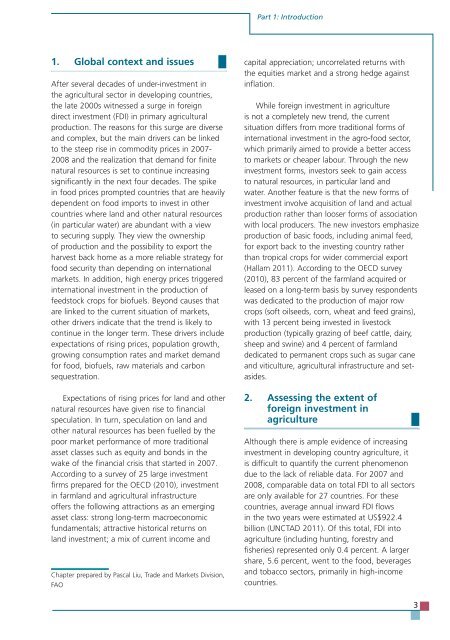TRENDS AND IMPACTS OF FOREIGN INVESTMENT IN DEVELOPING COUNTRY AGRICULTURE
TRENDS AND IMPACTS OF FOREIGN INVESTMENT IN DEVELOPING COUNTRY AGRICULTURE
TRENDS AND IMPACTS OF FOREIGN INVESTMENT IN DEVELOPING COUNTRY AGRICULTURE
Create successful ePaper yourself
Turn your PDF publications into a flip-book with our unique Google optimized e-Paper software.
1. Global context and issues <br />
After several decades of under-investment in<br />
the agricultural sector in developing countries,<br />
the late 2000s witnessed a surge in foreign<br />
direct investment (FDI) in primary agricultural<br />
production. The reasons for this surge are diverse<br />
and complex, but the main drivers can be linked<br />
to the steep rise in commodity prices in 2007-<br />
2008 and the realization that demand for finite<br />
natural resources is set to continue increasing<br />
significantly in the next four decades. The spike<br />
in food prices prompted countries that are heavily<br />
dependent on food imports to invest in other<br />
countries where land and other natural resources<br />
(in particular water) are abundant with a view<br />
to securing supply. They view the ownership<br />
of production and the possibility to export the<br />
harvest back home as a more reliable strategy for<br />
food security than depending on international<br />
markets. In addition, high energy prices triggered<br />
international investment in the production of<br />
feedstock crops for biofuels. Beyond causes that<br />
are linked to the current situation of markets,<br />
other drivers indicate that the trend is likely to<br />
continue in the longer term. These drivers include<br />
expectations of rising prices, population growth,<br />
growing consumption rates and market demand<br />
for food, biofuels, raw materials and carbon<br />
sequestration.<br />
Expectations of rising prices for land and other<br />
natural resources have given rise to financial<br />
speculation. In turn, speculation on land and<br />
other natural resources has been fuelled by the<br />
poor market performance of more traditional<br />
asset classes such as equity and bonds in the<br />
wake of the financial crisis that started in 2007.<br />
According to a survey of 25 large investment<br />
firms prepared for the OECD (2010), investment<br />
in farmland and agricultural infrastructure<br />
offers the following attractions as an emerging<br />
asset class: strong long-term macroeconomic<br />
fundamentals; attractive historical returns on<br />
land investment; a mix of current income and<br />
Chapter prepared by Pascal Liu, Trade and Markets Division,<br />
FAO<br />
Part 1: Introduction<br />
capital appreciation; uncorrelated returns with<br />
the equities market and a strong hedge against<br />
inflation.<br />
While foreign investment in agriculture<br />
is not a completely new trend, the current<br />
situation differs from more traditional forms of<br />
international investment in the agro-food sector,<br />
which primarily aimed to provide a better access<br />
to markets or cheaper labour. Through the new<br />
investment forms, investors seek to gain access<br />
to natural resources, in particular land and<br />
water. Another feature is that the new forms of<br />
investment involve acquisition of land and actual<br />
production rather than looser forms of association<br />
with local producers. The new investors emphasize<br />
production of basic foods, including animal feed,<br />
for export back to the investing country rather<br />
than tropical crops for wider commercial export<br />
(Hallam 2011). According to the OECD survey<br />
(2010), 83 percent of the farmland acquired or<br />
leased on a long-term basis by survey respondents<br />
was dedicated to the production of major row<br />
crops (soft oilseeds, corn, wheat and feed grains),<br />
with 13 percent being invested in livestock<br />
production (typically grazing of beef cattle, dairy,<br />
sheep and swine) and 4 percent of farmland<br />
dedicated to permanent crops such as sugar cane<br />
and viticulture, agricultural infrastructure and setasides.<br />
2. Assessing the extent of<br />
foreign investment in<br />
agriculture <br />
Although there is ample evidence of increasing<br />
investment in developing country agriculture, it<br />
is difficult to quantify the current phenomenon<br />
due to the lack of reliable data. For 2007 and<br />
2008, comparable data on total FDI to all sectors<br />
are only available for 27 countries. For these<br />
countries, average annual inward FDI flows<br />
in the two years were estimated at US$922.4<br />
billion (UNCTAD 2011). Of this total, FDI into<br />
agriculture (including hunting, forestry and<br />
fisheries) represented only 0.4 percent. A larger<br />
share, 5.6 percent, went to the food, beverages<br />
and tobacco sectors, primarily in high-income<br />
countries.<br />
3


